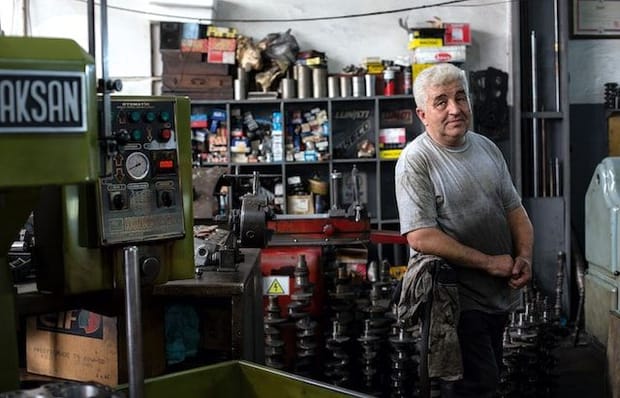For most managers and business owners, job and exit interviews are par for the course — important steps in the people management process that they'd never dream of skipping.
Stay interviews, however, are still far less known, despite the multitude of benefits they have to offer.
Here’s everything managers should know about stay interviews, including tips on how to conduct them, example questions to ask, and how the results can help you save on costly recruitment and training.
What is a stay interview?
What is the purpose of a stay interview?
How to conduct a stay interview
Example questions to ask during a stay interview
What is a stay interview?
A stay interview, also known as a retention review, is when a manager or business owner meets with a valued member of staff to find out what they enjoy most about their job and why.
Stay interviews are also used to give employees the opportunity to discuss the things that might not be working quite so well at a business, with staff invited to make suggestions for how to remedy them.
Unlike exit interviews, which are held only when a member of staff is leaving, stay interviews are conducted while someone's employed and with the express goal of holding onto them for as long as possible.
Stay interviews are usually conducted on a one-to-one basis by employers or line-managers, and are often kept relatively informal in order to encourage free-flowing conversation.
What is the purpose of a stay interview?

Broadly speaking, the main purpose of a stay interview is to help decrease staff turnover and for managers to discover ways to make their business a better place to work.
This can be broken down even further, however, with the main purposes of stay interviews falling into three distinct categories:
Information gathering
Stay interviews provide an opportunity to find out what your employees enjoy about their job. This information can then be used to find ways to improve the overall employee experience at your business — both for the individual employee you’re interviewing and the wider team — with a view to encouraging them to stay.
Building trust
Often, when managers sit down to talk with their staff it’s because it's standard protocol or there’s a problem. Stay interviews, on the other hand, give managers and employees a different and positive reason to meet, helping them build a rapport as well as signalling to staff that their opinions are valued.
Professional development
Stay interviews can help managers understand what motivates their staff on a more personal level. This information can be used to help keep staff engaged in their work and look for ways to develop their skills further with a view to offering them more responsibility in the future.
Spotting problems early
Managers can also use stay interviews to invite staff to discuss any minor grievances they might have, nipping problems in the bud before they grow to become something that an employee considers leaving the business over.
How to conduct a stay interview

There’s no one correct way to conduct a stay interview, and the way you run them at your business will depend on everything from the number of staff you employ to the remit of each individual role.
That being said, here are some tips to help you get started with your first round of stay interviews:
1. Decide which staff to talk to
In an ideal world, you’d be able to sit down with every one of your employees to find out what they like — and don’t like — about their role. Sadly, most managers simply don’t have the time and resources to do this, so it’s usually more practical to start with a small number (3-5 is a good start) of your best-performing and most enthusiastic team members.
If you’re not sure who to invite, draw on things like shift data and timesheet records to help you spot employees who are punctual and have good attendance records.
2. Schedule interviews in advance
Discreetly let each of your chosen employees know well in advance that you’d like to meet and what you’d like to talk about (no one enjoys being invited to a meeting where they don't know what to expect!).
Try to give enough notice so that they have time to think about what they'll say, but make it clear that this is meant to be a free discussion rather than a test or appraisal.
It’s best to schedule 30 minutes to an hour for each stay interview.
3. Hold them privately
Employees need to feel confident that they can speak openly during their stay interview. Try to conduct them in a quiet spot away from the wider team. If there’s nowhere suitable on-site, consider heading out for a coffee at a nearby business or even conducting them over the phone (though in-person is definitely preferred).
Be sure to conduct stay interviews on company time — it’s unfair to ask staff to give up their own time for something that will largely benefit the business.
4. Use a stay interview template
It’s important to take plenty of notes during your stay interviews, and to make sure that each one follows a similar pattern so that nothing gets missed.
To facilitate this, consider creating a simple stay interview template broken into sections to guide the conversation. Check out our example stay interview questions below.
5. Collate your responses
Each employee should be interviewed and responded to individually, but collecting all of the responses together can be beneficial to your business longer term.
Do the changes you make off the back of stay interviews have a noticeable impact on employee retention rates? Do you notice any change in instances of employee absence or lateness?
Try to conduct stay interviews every 6–12 months to build up a bank of data to base future decisions on.
Example questions to ask during a stay interview

There’s no maximum or minimum number of questions that you should ask during a stay interview, but it’s a good idea to prepare a list of conversation starters to ensure that you cover the areas you want to focus on.
Bear in mind that it’s fine to go off-script from time to time — stay interviews should be more of a free-flowing conversation than a Q&A — but be sure to keep a record of your employees’ responses and any follow-up questions you'd like to ask.
Here are some potential stay interview questions — about the employee, about their role, and about your business as a whole.
About them
1. Would you say that you’re happy working here?
2. Are there any skills you posses that you feel you could be using more?
3. Have you ever been tempted to look for another job? What prompted you to stay?
4. What would another employer have to offer you in order to tempt you away?
5. Do you feel that you receive the recognition you deserve?
About their role
6. What’s the thing you enjoy most about your job?
7. What do you enjoy least about your role?
8. Are there any parts of your job where you could use more training or support?
9. Do you have any suggestions for changes we could make to improve your role?
10. Are there other roles within the business that you have your eye on?
About the business
11. If a job came up here, would you recommend it to someone you knew? If not, why?
12. Can you think of anything we could do that would make us a more attractive prospect to jobseekers?
13. Is there anything about the business that you think might put people off working for us?
14. How do you think we can make our employees happier?
15. What would you say is our biggest challenge or weakness as a business?
Wrap-up
Done properly and regularly, stay interviews may reduce staff turnover at virtually any business.
Stay interviews give managers an opportunity to find out what their staff love about working for them, but also what could be changed to make them happier and to convince them to stick around.
Try to conduct stay interviews every 6–12 months with your most valued and enthusiastic staff, and be sure to take their feedback on board wherever possible.






